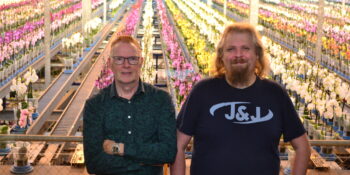BM Roses is a five-hectare pot rose nursery in the Dutch village of Maasland. The business started seventy years ago growing tomatoes, later transitioning to cut roses. “When many Dutch cut rose growers moved to Africa, we switched to pot roses. It’s going well, and we’re happy,” says co-owner Jaime van Marrewijk.

Jaime van Marrewijk
Sustainability is an important factor in pot rose production at BM Roses. Van Marrewijk: In terms of crop protection, we are increasingly shifting towards organic solutions. This is partly because some products are no longer permitted, but also because there are more and more effective biological options available. This applies to both beneficial organisms and biostimulants.”
Energy usage and feed-in
The pot rose is a long-day plant and therefore needs a lot of light. “That’s why we use a CHP, which provides both heat and electricity. This also enables us to feed energy back into the grid.” The energy grid is quite full, but there is still room to feed in, says Van Marrewijk. “The demand for electricity is continuing to grow, so feeding back into the grid is still a seamless process.”
Blijdorp Zoo closes the circle
At BM Roses, pot roses are pruned twice to achieve a better plant shape. “We use the prunings as cuttings to grow new plants, but the first trimmings are not long or strong enough for this.” So the first rose leaf prunings go to Rotterdam Zoo (Diergaarde Blijdorp), where they make a tasty meal for giraffes, rhinos and other animals. “In the past they had to freeze tree leaves to feed the animals later in the year; now they have fresh leaves all year round.”
MPS as a helping hand
 BM Roses is MPS-A certified. “Every month, we report how much and which crop protection agents we have used, how much water, gas and electricity we have used, how much electricity we have fed back into the grid and which assimilation lamps have been on. MPS then assesses how we’re doing in terms of environmental friendliness.”
BM Roses is MPS-A certified. “Every month, we report how much and which crop protection agents we have used, how much water, gas and electricity we have used, how much electricity we have fed back into the grid and which assimilation lamps have been on. MPS then assesses how we’re doing in terms of environmental friendliness.”
The company also holds MPS-GAP and MPS-SQ certifications. “For these, we undergo an annual audit during which we provide documents on crop protection, sustainability and the working conditions for our staff. These audits keep you on your toes as a business: they make you pay attention to smaller things you would otherwise overlook if you didn’t have to do them every year. This way, the important issues are always at the back of your mind.”



